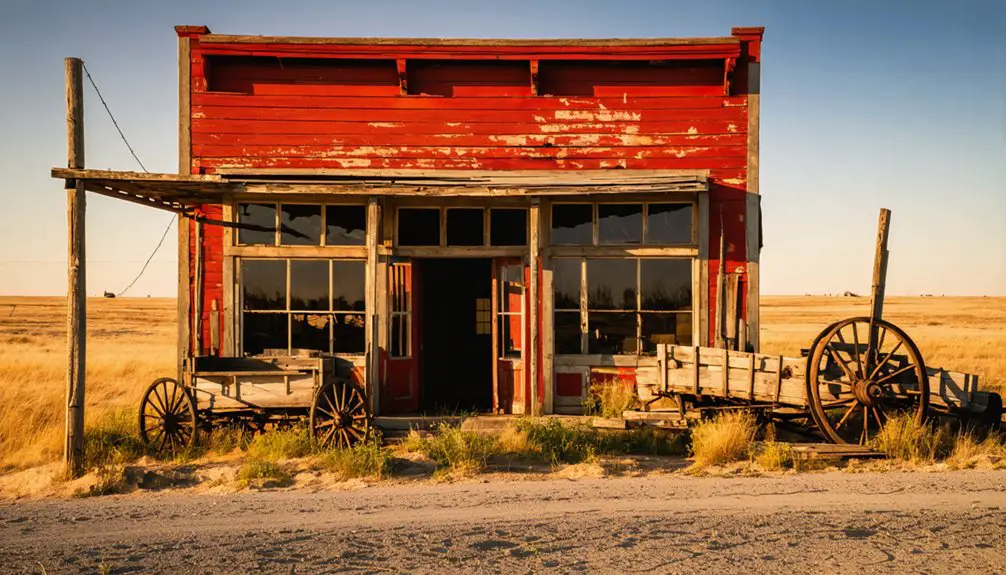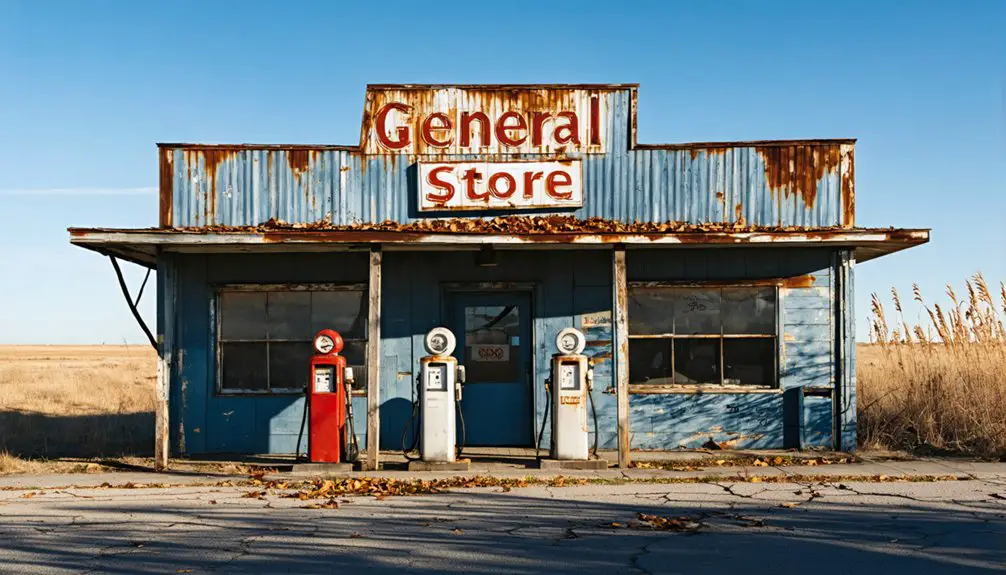You’ll find Mayes, Oklahoma nestled in Cherokee County, where it emerged after the 1893 Cherokee Outlet Opening. John H. Porterfield’s store and post office establishment in 1896 formed the community’s early nucleus. The town flourished through wheat farming and strategic railroad connections, reaching its peak population of 324 in the 1920s. Though economic hardships and World War II led to its decline, Mayes’ preserved buildings and landmarks tell compelling stories of Oklahoma’s agricultural heritage.
Key Takeaways
- Mayes peaked at 324 residents in the 1920s before declining into a ghost town due to economic and agricultural pressures.
- The town’s abandonment accelerated during World War II as residents left for military service and wartime employment opportunities.
- Key historic buildings, including May State Bank, Cottage Hotel, and a two-story brick schoolhouse, remain as remnants of past prosperity.
- Recurring floods from Beaver River and Otter Creek contributed to the town’s eventual abandonment and deterioration.
- The ghost town preserves early Oklahoma settlement history through its abandoned grain elevators, railway infrastructure, and commercial buildings.
The Birth of a Prairie Town (1893-1896)

Three crucial events marked the birth of May, Oklahoma in the 1890s: the Cherokee Outlet Opening of 1893, John H. Porterfield’s arrival from Illinois to establish the first store, and the post office’s establishment in 1896.
You’ll find that settler experiences during this period centered around Porterfield’s store, which became the heart of early community formation.
The town’s name carries two origin stories – either honoring Porterfield’s daughter Jessie May or landowner Joseph A. Innis’s daughter May.
Early settlers faced the challenges of prairie life, building makeshift homes while dealing with flooding from the nearby Beaver River and Otter Creek. Like many boomtowns across Oklahoma, May experienced rapid growth as pioneers sought opportunities in the newly opened territory.
The growing settlement focused on wheat farming and cattle raising, with the store and post office serving as essential gathering spots for pioneers seeking to forge new lives in Oklahoma Territory.
The town was officially platted in 1902, marking a significant step in its development as a frontier community.
Railroad Dreams and Economic Growth
You’ll find that Mayes County’s transformation began when the Missouri, Kansas and Texas Railroad built through the region in 1871-72, bringing essential transportation links that connected the area to larger markets.
The railroad’s arrival, backed by European investors who saw potential in Oklahoma Territory, spurred the development of agricultural shipping infrastructure that turned Mayes into a bustling wheat distribution hub. Similar to how the Amsterdam Stock Exchange provided crucial funding for Oklahoma’s rail expansion, these European investments helped establish vital transportation networks.
Local farmers quickly capitalized on the new rail access, expanding their wheat, corn, and soybean operations while establishing the town as a key point along the region’s growing commercial network. The area’s rich Prairie Plains landscape in the western portion of the county provided ideal conditions for these agricultural endeavors.
Railroad Spurs Economic Development
The arrival of the Oklahoma Central Railway and Missouri, Oklahoma and Gulf Railway in the early 1900s transformed Mayes County’s economic landscape through strategically placed rail spurs and depots.
Railroad expansion created powerful economic incentives that shaped the region’s development and commerce.
You’ll find these rail connections revolutionized local industry through:
- Strategic spur placement that connected towns like Strang to main lines, sparking new settlements
- Enhanced shipping capabilities for coal, cotton, and livestock to wider markets
- Mixed revenue streams from passenger transport and freight services
- Creation of industrial zones with extensive rail networks, including the 38-mile spur system at MidAmerica Industrial Park
This rail infrastructure didn’t just move goods – it established the foundation for wartime industry and peacetime manufacturing that would define the region’s economic future.
The railway system’s profitability relied heavily on coal from Lehigh which was transported to Purcell for use in Santa Fe steam locomotives.
The Oklahoma Ordnance Works facility became a major economic driver during World War II, with the rail system essential for transporting munitions and materials.
Wheat Shipping Hub Emerges
Following completion of the Wichita Falls and Northwestern Railway in spring 1912, May, Oklahoma quickly emerged as an essential wheat-shipping hub connected to the Missouri, Kansas and Texas Railway network.
The town’s wheat logistics infrastructure rapidly expanded with wooden grain elevators and feed barns supporting the burgeoning grain economy. The C. B. Cozart Grain Company became a cornerstone business during this prosperous period.
You’d find May’s fertile Prairie Plains soil yielding impressive harvests, often reaching 30-40 bushels per acre in good years. The mild winters allowed farmers to maintain year-round agricultural operations.
The town’s strategic position helped local farmers connect to national markets, while supporting auxiliary businesses in milling and grain handling.
Life in Early Mayes
During the 19th century, life in early Mayes centered around a rich blend of Cherokee, Osage, and European-American influences following forced Cherokee relocations.
Early settlers found themselves immersed in a community shaped by tribal governance, with Cherokee influence extending through every aspect of daily life. Agriculture formed a critical foundation, with crops and cattle sustaining the local economy. Archaeological discoveries revealed that the area had been inhabited since 6000 BC, showing an extensive history of human settlement.
You’d have discovered a vibrant society built around:
- Trading posts established by French voyageurs like Jean Pierre Chouteau, where you could exchange goods and information
- Mission schools and the region’s first printing press at Union Mission, providing education and cultural preservation
- Stage stops along the Texas Road, connecting you to crucial transportation routes
- Tight-knit family networks built around agricultural homesteads and salt manufacturing operations
The Missouri-Kansas-Texas Railroad‘s arrival in 1871 transformed these early settlements, expanding your opportunities for commerce and connectivity beyond tribal territories.
Agricultural Heritage and Wheat Trading
When the Wichita Falls and Northwestern Railway arrived in 1912, you’d find Mayes quickly establishing itself as an essential grain transport hub with new commercial elevators and feed barns.
You’ll note how the railroad’s presence enabled local farmers to efficiently ship their wheat yields, which ranged from 10 to 40 bushels per acre across the fertile Prairie Plains soil.
The town’s strategic position along the Missouri, Kansas and Texas Railway subsidiary helped cement Mayes’s role in the region’s agricultural economy, particularly in wheat trading during its 1913 incorporation period.
Railroad Grain Transport Hub
As the Missouri, Kansas and Texas Railroad established essential rail connections in Mayes County during 1871-72, the town of Mayes emerged as an important grain transport hub that would shape Oklahoma’s agricultural landscape.
The strategic rail connections transformed local grain logistics, enabling farmers to efficiently move their harvests to broader markets.
You’ll find the railroad’s impact reflected in these key developments:
- Rail systems handled 46% of Oklahoma’s grain shipments, with wheat comprising 62% of crop production.
- Terminal elevators served as critical consolidation points for regional grain collection.
- Multiple rail lines provided cost-effective transport options for local farmers.
- Rail-connected storage facilities cemented Mayes’s role in Oklahoma’s agricultural economy.
The Missouri, Oklahoma and Gulf Railway’s arrival in 1913 further enhanced the region’s transport capacity, solidifying Mayes’s position as a crucial agricultural shipping center.
Agricultural Trading Legacy
The fertile Ozark Plateau soil of Mayes County established its reputation as a premier agricultural trading center, where diverse crops flourished alongside robust livestock operations.
You’ll find the region’s agricultural evolution reflected in its impressive wheat yields, ranging from ten to forty bushels per acre, complemented by feed crops like cotton-seed, alfalfa, and kafir.
The county’s integration into essential trade networks accelerated after railroad developments, making it a significant wheat-shipping point.
You’ll discover how local infrastructure supported this boom through grain elevators and feed barns.
The agricultural landscape thrived with Jersey, Holstein, and Shorthorn cattle operations, while butter production from local creameries demonstrated the area’s economic diversity.
These combined enterprises created a robust trading legacy that shaped Mayes County’s agricultural identity well into modern times.
Notable Buildings and Landmarks

Brick and mortar monuments to May’s prosperous past still dot the Oklahoma ghost town’s landscape.
The historic architecture reflects the town’s early 20th-century prosperity, anchored by the prominent two-story brick schoolhouse built in 1913. You’ll find community landmarks that once served as essential centers of commerce and education, including the May State Bank, Cottage Hotel, and Keystone Hotel.
The town’s most significant structures tell the story of its boom years:
- The 1913 schoolhouse stands as a tribute to the community’s commitment to education
- May State Bank’s building represents the town’s financial prominence
- The C.B. Cozart Grain Company and elevator showcase agricultural commerce
- Local establishments like May Restaurant and City Meat Market reflect daily life
Transportation Hub at the Crossroads
Located at the convergence of essential transportation arteries, May emerged as an important transit hub in early Oklahoma Territory.
May’s strategic location at major transportation crossroads transformed it into a vital hub within Oklahoma Territory’s early development.
You’ll find the town’s transportation significance reflected in its strategic position along both the East Shawnee Trail and Texas Road, with the addition of multiple railways enhancing its connectivity.
The Missouri, Kansas and Texas Railroad’s arrival in 1871 sparked the town’s growth, while the Missouri, Oklahoma and Gulf Railway’s completion in 1913 further cemented May’s role as a regional nexus.
The economic interdependence between transportation and commerce shaped the town’s development.
You can trace May’s prosperity through its grain elevators, feed barns, and commercial buildings that sprouted up around the rail lines.
However, when railroad services declined and routes shifted, the town’s liveliness faded, ultimately leading to its abandonment.
Community Spirit and Social Life

During its heyday, May’s vibrant community spirit emanated from key social institutions that anchored daily life. You’d find residents gathering at the May State Bank, Cottage Hotel, and City Meat Market, forging social connections through daily commerce and conversation.
The two-story brick schoolhouse, built in 1913, served as more than just an educational facility – it became the heart of community gatherings.
Here’s how May’s social fabric was woven together:
- Seasonal farming activities brought neighbors together for planting and harvest.
- The grain elevator and feed barn created natural meeting spots for daily interaction.
- Local newspapers kept everyone connected through shared stories and announcements.
- School events and performances united families from town and surrounding farmlands.
The Path to Decline
Despite its earlier promise as a thriving agricultural hub, May’s decline began in the 1920s when its population peaked at 324 residents before starting a steady downward spiral.
You’ll find the town’s story marked by relentless economic hardships, as cattle and wheat farming couldn’t withstand external market pressures. World War II accelerated the exodus when residents left for military service or wartime jobs elsewhere.
Environmental challenges, particularly flooding from the North Canadian River and Otter Creek, dealt additional blows to the community.
The loss of essential institutions – including May High School in 1957 and the MK&T Railway in 1972 – sealed the town’s fate.
Preserving Mayes’ Legacy

While Mayes’ population dwindled to near extinction, efforts to preserve its legacy have gained momentum through Oklahoma’s extensive preservation initiatives.
The Oklahoma Historic Preservation Office leads community engagement efforts to protect this piece of regional heritage through their “Tomorrow’s Legacy” plan.
You’ll find several preservation strategies actively working to save Mayes’ history:
- Environmental cleanup programs targeting mining contamination, similar to nearby Picher
- Documentation and potential inclusion in the National Register of Historic Places
- Educational partnerships with schools and universities to research and preserve local history
- Digital platforms and interpretive signage to share Mayes’ story with visitors
These combined efforts guarantee that despite its ghost town status, Mayes’ cultural significance won’t be forgotten in Oklahoma’s rich historical tapestry.
Oklahoma’s Ghost Town Phenomenon
As Oklahoma’s history unfolds across its vast landscape, you’ll discover an extraordinary network of over 2,000 ghost towns that tell compelling stories of boom-and-bust cycles, environmental challenges, and shifting economic fortunes.
These ghost towns emerged primarily from dramatic economic shifts, with many communities experiencing more than 80% population decline from their peak.
You’ll find abandoned settlements that once thrived on oil booms, railroad commerce, and even illegal liquor trade along state borders. When railroads rerouted, oil wells dried up, or new highways bypassed these towns, their liveliness quickly faded.
Northern and western Oklahoma hold numerous examples of these lost communities, where you can still find remnants of post offices, schools, and churches that once served thriving populations but now stand as silent witnesses to Oklahoma’s dynamic past.
Frequently Asked Questions
Are There Any Remaining Residents Living in Mayes Today?
Like tumbleweeds drifting through time, you’ll find about 40 hardy souls still call this place home, though ghost sightings outnumber the current population in this fading prairie settlement.
What Happened to the Original Jessie May That Mayes Was Named After?
You won’t find definitive records of Jessie May Porterfield’s fate in history. While she gave Mayes its name through her father’s influence, her life after the town’s founding remains a mystery.
Did Any Major Crimes or Notable Incidents Occur in Mayes?
You won’t find any documented unsolved mysteries or historical crimes in the town’s records. Unlike other Oklahoma ghost towns known for lawlessness, it remained a peaceful agricultural community throughout its existence.
What Natural Disasters Has Mayes Experienced Throughout Its History?
While specific natural disasters aren’t directly documented, you’d find the area faced typical Plains state threats – tornadic storms likely caused tornado impact, and the region’s geography made it vulnerable to flood damage.
Are There Any Annual Events or Reunions Still Held in Mayes?
You won’t find any annual celebrations or community gatherings specifically held in Mayes today. While nearby Pryor hosts various events throughout the year, none are connected to this abandoned settlement.
References
- https://www.legendsofamerica.com/may-oklahoma/
- https://en.wikipedia.org/wiki/List_of_ghost_towns_in_Oklahoma
- https://www.okhistory.org/publications/enc/entry?entry=GH002
- https://www.youtube.com/watch?v=zTKa5i1czdE
- https://www.kosu.org/local-news/2014-05-23/ghost-towns-all-black-oklahoma-towns
- https://www.wikiwand.com/en/articles/List_of_ghost_towns_in_Oklahoma
- https://newforums.com/our-titles/best-of-the-region/places-routes/ghost-town-tales-of-oklahoma-unforgettable-stories-of-nearly-forgotten-places/
- https://www.okhistory.org/publications/enc/entry?entry=MA048
- https://www.okhistory.org/publications/enc/entry?entry=MA044
- https://en.wikipedia.org/wiki/Oklahoma_Central_Railroad_(1914–1942)



